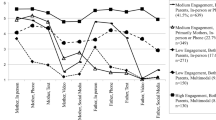Abstract
This study examines the effects of the age and sex of adolescent and the sex of parent upon adolescents' perceptions of the nature of their communication with each parent. Two hundred and ninety-six adolescents aged 13–17 years completed a communication schedule, rating 14 content areas along six process dimensions: frequency of conversation, initiator, levels of recognition of adolescents' opinion, self-disclosure, domination, and levels of satisfaction. Multivariate analyses of variance were conducted separately for each process dimension. Frequency ratings revealed that adolescent females of all ages reported talking more often with mothers than did adolescent males. Adolescent males, however, believed they talked more often than did females with fathers about interests, sexual issues, and general problems. Mothers were seen to initiate more conversations than fathers on a wide range of topics. Mothers were also perceived as more likely to recognize and accept the adolescents' opinions. Adolescent females believed they disclosed more to mothers than fathers, but males believed they disclosed equally to both parents. Males disclosed more to fathers than did females about their sexual or other problems, while females disclosed more often overall to their mothers than did males. Adolescent males were equally satisfied with their discussions with both parents, but females were more satisfied about conversations with mothers rather than fathers. In sum, the results suggest that mothers' more frequent initiation of discussions with their younger adolescents and their greater recognition of their opinions lead to older adolescents interacting more with mothers than fathers.
Similar content being viewed by others
References
Barnes, H. L., and Olson, D. H. (1985). Parent-adolescent communication and the circumplex model.Child Develop. 56: 438–447.
Bengtson, V. L., and Starr, J. M. (1975). Contrast and consensus: A generational analysis of youth in the 1970s. In Havighurst, R. J., and Dreyer, P. H. (eds.),Youth. The Seventy-Fourth Yearbook of the National Society for the Study of Education. University of Chicago Press, Chicago.
Callan, V. J., and Noller, P. (1986). Perceptions of communicative relationships in families with adolescents.J. Marriage Family 48: 813–820.
Caplow, T., Bahr, H. M., Chadwick, B. A., Hill, R., and Williamson, M. H. (1982).Middletown Families. University of Minnesota Press, Minneapolis.
Chartier, J., and Chartier, M. (1975). Perceived parental communication and self-esteem: An exploratory study.West. Speech 39: 26–31.
Cooper, C. R., Grotevant, H. D., Moore, M. S., and Condon, S. M. (1982, August). Family support and conflict: Both foster adolescent identity and role taking. Paper presented at the meeting of the American Psychological Association, August, Washington, DC.
Csikszentmihalyi, M., and Larson, R. (1984).Being Adolescent Basic Books, New York.
Grotevant, H. D., and Cooper, C. R. (1986). Individuation in family relationships: A perspective on individual differences in the development of identity and role-taking skill in adolescence.Human Development 29: 82–100.
Hartup, W. W. (1979). The social worlds of childhood.Am. Psychol. 34: 944–950.
Hunter, F. T. (1985). Individual adolescents' perceptions of interactions with friends and parents.J. Early Adoles. 5: 295–305.
Hunter, F. T., and Youniss, J. (1982). Changes in functions of three relations during adolescence.Develop. Psychol. 18: 806–811.
Huston, T. L., and Robins, E. (1982). Conceptual and methodological issues in studying close relationships.J. Marriage Family 44: 901–925.
Jacob, T. (1974). Patterns of family conflict and dominance as a function of child age and social class.Develop. Psychol. 10: 1–12.
Lynd, R. S., and Lynd, H. M. (1929).Middletown. Harcourt, Brace & Co., New York.
Montemayor, R. (1982). The relationship between parent-adolescent conflict and the amount of time adolescents spend alone and with parents and peers.Child Develop. 53: 1512–1519.
Montemayor, R. (1983). Parents and adolescents in conflict: All families some of the time and some families most of the time.J. Early Adoles. 3: 83–103.
Montemayor, R., and Hanson, E. (1985). A naturalistic view of conflict between adolescents and their parents and siblings.J. Early Adoles. 3: 83–103.
Noller, P., and Bagi, S. (1985). Parent-adolescent communication.J. Adoles. 8: 125–144.
Noller, P., and Callan, V. J. (1986). Adolescent and parent perceptions of family cohesion and adaptability.J. Adoles. 9: 97–106.
Noller, P., and Callan, V. J. (1988). Understanding parent-adolescent interactions: The perceptions of family members and outsiders.Develop. Psychol. 24: 707–714.
Noller, P., and Fitzpatrick, M. A. (1988).Perspectives on Marital Interaction. Multilingual Matters, Clevedon and Philadelphia.
Patterson, G. R. (1982).Coercive Family Process. Castalia Publishing Co., Eugene, OR.
Smith, K., and Forehand, R. (1986). Parent-adolescent conflict: Comparison and prediction of the perceptions of mothers, fathers and daughters.J. Early Adoles. 6: 353–367.
Steinberg, L. D., and Hill, J. P. (1978). Patterns of family interaction as a function of age, the onset of puberty, and formal thinking.Develop. Psychol. 14: 683–684.
Thornburg, H. D. (1981). The amount of sex information learning obtained during early adolescence.J. Early Adoles. 1: 171–183.
Youniss, J., and Smollar, J. (1985).Adolescent Relations with Mothers, Fathers, and Friends. University of Chicago Press, Chicago.
Author information
Authors and Affiliations
Additional information
Ph.D. in Social Psychology, University of Queensland. Her current interests are in the areas of marital and family communication, adolescence, and personal relationships.
Ph.D. in Social Psychology, Australian National University, with research interests in adolescence, marital communication, and childless couples.
Rights and permissions
About this article
Cite this article
Noller, P., Callan, V.J. Adolescents' perceptions of the nature of their communication with parents. J Youth Adolescence 19, 349–362 (1990). https://doi.org/10.1007/BF01537077
Received:
Accepted:
Issue Date:
DOI: https://doi.org/10.1007/BF01537077




